#she-ra analysis
Explore tagged Tumblr posts
Text



x / x / x
original thread 1
original thread 2
#spop#she ra#she-ra#she-ra and the princesses of power#catradora#catra#adora#analysis#she-ra analysis#spop analysis#memes#shitpost#screenshots#nd stevenson#nate stevenson
702 notes
·
View notes
Text
SPOP And Queer Joy Tw for transphobia, the Daily Wire, and getting kicked in the nuts
I was watching the most recent video from Some More News about a deeply stupid and bad and transphobic film from the daily wire called Ladyballers, and there was a scene they talked about where one of the main characters who was a guy that has been disguised as a woman for a couple weeks in order to win a woman's basketball tournament realizes he might actually be trans, and confesses this to the basketball coach who is his old friend and came up with the idea. The basketball coach then tells the trans character that she doesn't understand her own feelings and that the coach will help her figure it out. When she continues to insist that she's a trans woman, the coach kicks her in the nuts. And this made me realize the whole conservative mindset is based on an authority figure convincing people under them that they don't understand their own feelings and they don't know who they are, but the authority figure does. And the point of it all is to make someone never trust themselves or their own feelings ever.
And then I thought of the ending of She-Ra.
And I finally get why it felt so right and so triumphant and so different. Catra and Adora have been living with Shadow Weaver their whole lives, and Shadow Weaver has constantly been telling them who they're supposed to be, and it hurts both of them so much over the course of the series because Adora keeps trying to fit herself into that mold better (is helped in this endeavor by light hope) while catra is trying to break out of her mold to put herself in Adora's as the golden child
And then hoard Prime shows up as the ultimate example of an authority figure insisting that you don't understand yourself with the chips, which are literally a direct physical implementation of that idea!
And in what both of them think are their final moments alive, they kill the shadow Weaver in their heads, trust themselves to know who they are, and do what they've wanted to do the whole time. Catra stops trying to prove herself and admits that she cares and wants to just be enough without having to try. She stops caring about whether she's weak and says she loves someone. Adora stops trying to be the self-sacrificing hero and acknowledges that she can care about other people differently than just having to save them and she finally takes something she wants without worrying about the consequences.
They both say "screw authority, I know who I am and I'm going to let that out" because they both think they're about to die. And that one tiny moment of rebellion and understanding saves the entire goddamn universe. It terrifies Prime to the point that he can't even comprehend what's happened, and then it obliterates him and frees everyone he's ever hurt. It fixes everything
That one moment of queer Joy, even at the very end of the world, is all that it took.
94 notes
·
View notes
Text
the first two episodes of She-ra are still so fascinating to me because we're presented with these two characters, Adora and Catra, and from design alone, you can tell Catra's the more rebellious one: with the lack of Horde red on her clothes, ripped leggings, and spiky hair; contrasting Adora's zipped up, clean cut red jacket and practical ponytail. The first scenes show us Adora diligently preparing for the day and arriving on time for training, and Catra showing up partway through, seemingly slacking off, and using an underhanded tactic to secure victory. Catra jokes around and Adora joins in, but Adora straightens up and salutes the second Shadow Weaver appears. Catra slowly assumes attention, then falls back into a forced relaxed position, notably neglecting to salute. Throughout the episode, we see Adora is deferent, always toeing the line, where Catra is "disrespectful" and clearly disregards and resents authority. Yet, Adora is the one to defect.
Though we know Adora is the main character and must become She-ra and join the good guys™, it's still somewhat of a subversion of expectations. It drew in my attention immediately. What reason would Catra, who seemingly dislikes the Horde and is mistreated by Shadow Weaver, have to stay? How could Adora, who previously seemed so dedicated to serving the Horde with all of her being, leave so easily? It's such a good set up for the series
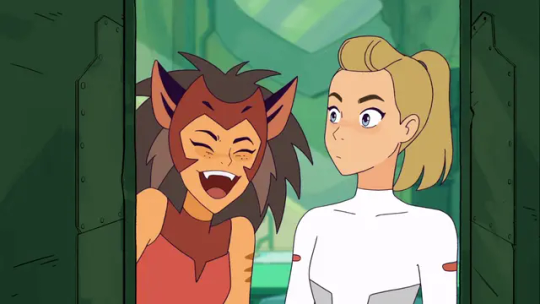

#rebel who wanted safety through power - the only way she knew#vs defector who believed in the righteousness of their cause#cl thoughts#she-ra is just such a good show#spop#shera#she ra#she ra and the princesses of power#spop season 1#catra#adora#catradora#spop meta#spop analysis#i could go on and on about the character design in this show#also yes catra has the darker orange-red headband but not the lighter red the rest of the cadets wear
411 notes
·
View notes
Text
I love the messy messy women of she ra so much
Adora, you self-sacrificing to a fault, poor communicator, valiant, full of a horrible inner critic, noble, victim of abuse who is not immune from repeating the cycle but despite it still tries her best to make things better, refusing to give up on anyone, determined, imperfect person, I love you.
Catra, you self-isolating, short-tempered, playful, scared, prone to lashing out, self-destructive, guarded, sweet, volatile, able to quickly do the right thing in a crisis, acknowledging of your previous mistakes and making an effort to fix all of the things you messed up, soft, imperfect person, I love you.
Glimmer, you hotheaded, overly confident, struggling to appreciate all you love until you lose it, wrapped up in your own beliefs, funny, quicker to act than to think, despite not realizing the error of her ways before the breaking point still trying to fix the results, learning to see nuance, imperfect person, I love you.
#the grammar here is not good but I digress#‘[adora or catra or glimmer] did so much wrong’ yeah! I wouldn’t feel so strongly if they were just paragons of virtue. that’s boring#she ra#spop#she ra and the princesses of power#adora#catra#glimmer#me posting <3#analysis
297 notes
·
View notes
Text
That first locker scene and how it perfectly encapsulates Catra and Adora's trauma dynamic
NGH I've been wanting to talk about a particular screenshot in this scene for a while and I guess today is the day. Let's talk about Catradora's introduction post-exercise.

We start here, with them joking around after training. They're at ease with each other, but also Catra doesn't feel as vulnerable as to uncross her arms or get closer to her. This is a person who likes Adora but won't be super explicit about showing it. Adora obviously feels comfortable, her arms are crossed but it's because of uncontrollable laughter and her eyes are closed, showing trust.

Shadow Weaver calls Adora's name and you can immediately tell the ease is gone.
Adora feels the need to stand at attention, slightly scared about being caught relaxing. This is a person Adora respects.
Catra does not respect Shadow Weaver, so she locks eyes with her and doesn't stand up, her crossed-arms giving her a sense of safety and protection.
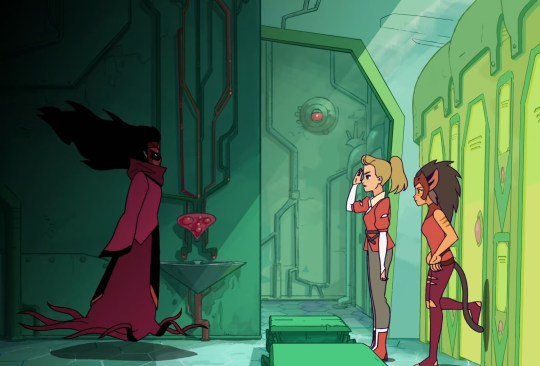
But Catra is still scared of Shadow Weaver, so she does end up standing up, just later. She also refuses to salute. Her defiance against her abuser comes out in small gestures like this, but ultimately she will obey because of the fear of punishment.

Adora wants to keep Catra safe while still maintaining her some-what comfortable position in the system. She does this by trying to show SW that Catra is worthy. She has the flawed belief that if she just tries hard enough, SW will change her mind about Catra and start treating her well.
Meanwhile Catra is pissed at what she sees as Adora pitying her. She does not want her help, it makes her feel condescended. She has always seen Adora get recognized for everything, so when she re-directs the praise SW gives her, Catra just sees it as humble bragging. "Oh you get praised for everything so now that you don't need the praise, you're second-hand giving it to me even though you just told me I was lazy and immature for not doing the exercise properly so I know you don't really mean it."

Adora's tactic (obviously) doesn't work (bc SW's hate for Catra is so internalized), and she's upset by the degradation SW's giving Catra, knowing it will really hurt her best friend. Catra is visibly hurt and frustrated...
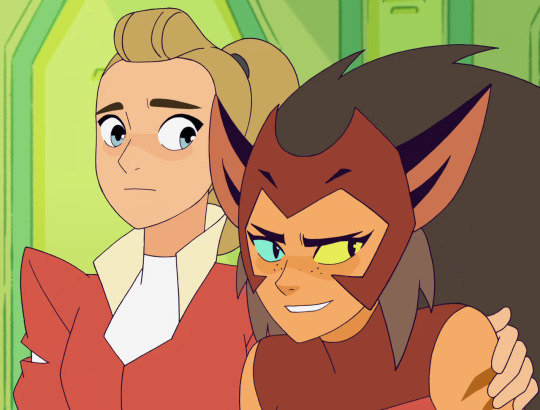
...But she doesn't want to show SW her words hurt and actually cut deep, so she tries making a joke.
Adora is worried for her bc she knows how SW reacts to being talked-back to. And she knows Catra knows too. This is the face of someone who is thinking "why are you doing this to yourself?" Adora has probably being told by SW that she is only abusive towards Catra because she is disobedient and insolent. So unfortunately she has internalized the narrative that Catra is somewhat doing it to herself. She most likely thinks that if Catra just did as she was told and behaved, she wouldn't get treated like this.

This, THIS is the screenshot that started this whole-ass rambling. It's just perfect.
Not only do you get the obvious foreshadowing that Catra will be “enveloped in shadows” for most of the show (trauma-based downward spiral), it also shows that these "shadows" (trauma) are from SW. You also get from her expression that she is so freaking angry, but she looks away because she is (understandably) scared. She is not only angry at SW, but also at herself bc of her fear of punishment, she feels weak and pathetic.
You also get Adora’s passivity at the abuse. She looks scared for her, but isn’t willing to step in to stop it. This is abuse that has become so normalized that she is scared about the inevitability of it happening, but isn’t willing to do more than to check in with Catra after it happened bc of her safety in the system and bc she partially blames Catra for it. (She tells Catra "you are kind of disrespectful" when Catra later asks what SW's problem is with her)
Adora’s face is “I am scared for you, please don’t talk back to her bc you know things will get worse for you.” It’s the face of anticipation, of hundreds of times where Catra was punished in front of her and was told "You need to keep her under control" and understanding she failed to do that.

SW tells Adora to walk with her, and she immediately releases Catra and is excited about the inevitable praise she will be getting. Catra obviously is very distressed at the sudden departure without even looking back.

Adora realizes she was going to leave before checking if Catra was okay, so she stops in her tracks.
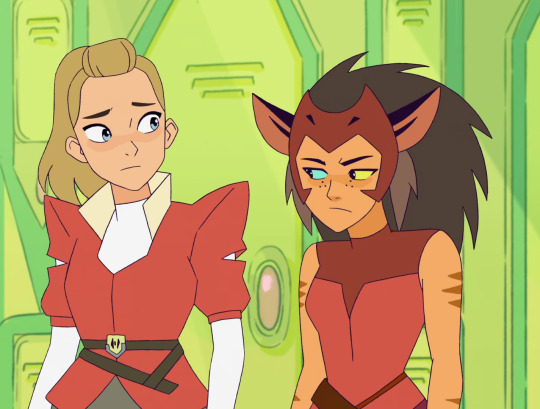
Catra's ears IMMEDIATELY perk up, begrudgingly feeling nice that Adora looked back.
Adora's expression is a question "are you okay?"

Catra shrugs: "not really, but it's fine"

Adora seems satisfied with this, so she feels okay leaving now.
Catra's expression makes me AUGH bc it's this "I really don't want you to go. I know I said I was fine but I'm actually really not and I could really use comfort (hence the crossed-off arms) but I can't tell you that bc I dont want you to think I'm weak and you need to go so whatever."
This scene is so freaking clever. While dialogue is important, you can tell SO much from their expressions and body language. It just perfectly encapsulates their trauma responses and how their dynamic changes when their abuser is present. It just also shows that their relationship was ALWAYS going to break bc of the rift SW created between them. Their communication is extremely faulty here, even though you can see how deep they know each other (esp in the silent check-in scene).
Anyway these two make me go RAH as per usual.
#spop#catradora#spop analysis#spop adora#spop catra#BDL analyzes#I wrote this instead of eating breakfast at a decent time#Instead of photosynthesis I blorbosynthesize#she ra
327 notes
·
View notes
Text
Ok so She-Ra pulled such a great hat trick with Hordak's characterization, and I LOVE it
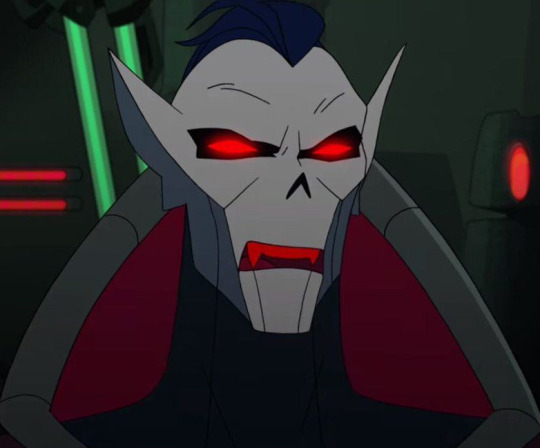
One of my favorite things about 2018 She-Ra is Hordak's story and development (and Entrapdak cough but that's not the point of this particular post), and the cleverest thing is that so much of it is actually being set up and told to us in seasons 1 and 2 before we even realize that that's what's happening.
When we first see Hordak in the show, he's giving "generic evil overlord" vibes. Garden-variety baddie. Maybe a little more reasonable than some and clearly capable of long-term thinking, but that just serves to make him intimidating. Everything about him--the way he runs his empire, his armor, his color scheme, his minion, his Villainous Eye Makeup(TM), even his name--are all projecting to the audience "yup, Acme Bad Guy here. Move right along."

But then, backstory. And everything snaps into focus. Not only is it one of the first big oh SHIT moments of the show, where we suddenly zoom out and realize that there is SO much more going on than we realized--it's also the start of the audience seeing Hordak as a character rather than an archetype. Suddenly we realize that he's not conquering Etheria because he wants power, or hates happiness and sparkles, or whatever--he's doing it out of a desperate attempt to prove his worth to his brother/creator/god. This moment where Hordak lets Entrapta in is also the moment the show lets us in on what makes our favorite spacebat tick.
On top of that, we've also seen him bonding with Entrapta and opening up to this person that he respects and trusts...probably the only person he's ever respected or trusted apart from Prime. And she's Etherian--someone of a lower species, someone he's supposed to subjugate, someone who he has been raised and trained and programmed and mind-controlled into believing is below him in every way.
But instead she's brilliant and creative and mesmerizing. She's not afraid of him, and she's fascinated with his work. For the first time since being abandoned by Prime, Hordak finally has someone that he can talk to, who is on his level and both understands and cares about the science! (because he is a giant nerd). She's kind to him, a mere defect. And it just sends his whole worldview into a spin, and that's all before--
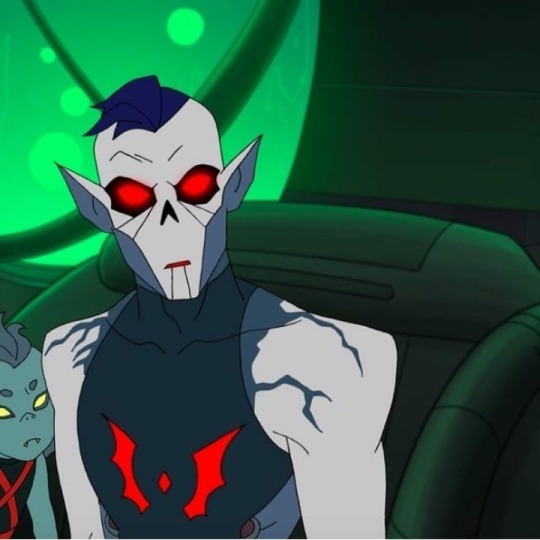
Bam, mans is a goner. Entrapta's "Imperfections are beautiful" comment punches right through all the toxic bs that Hordak has been steeped in his entire life. You can see on his face here--I think it's the moment Hordak fell in love with Entrapta, but this is also the face of a spacebat reevaluating his entire worldview. If Entrapta, who is amazing, believes something different from Prime...what does that mean? If Entrapta, who is brilliant, believes that he is worth something, and that she herself is a failure...
Well. We know what happens after that, and how Hordak begins to doubt, and eventually fights back against Prime (and remembers his love for Entrapta after TWO mind wipes help my heart ack). But we also get to see what life in the Galactic Horde looks like: the only life Hordak ever knew before coming to Etheria.

It's not nice.

It's really not nice.
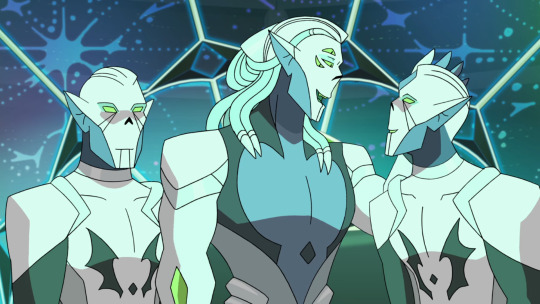
Prime operates in a very specific way, and we learn a lot about it in season 5. Prime expects complete obedience, devotion and worship from his clones. He allows no individuality from his subjects, not even a name. Failure or deviations are punished, mind-wiped, or destroyed. We even learn from Wrong Hordak that facial expressions are considered a privilege reserved for Prime (apart from, presumably, expressions of rapture caused by being around Prime).
And once we learn all of this, suddenly thinking about season 1 Hordak becomes very interesting indeed. The time we spend with the Galactic Horde and Prime throws absolutely everything that we know about Hordak into a whole new context. Now all those traits that made him a generic villain are actually hugely effective characterization! And what that characterization is telling us is that Hordak had already moved much farther away from Prime than we (or, probably, he) had realized, even long before he met Entrapta.
Horde Prime does not allow his underlings to have names, personalities, or any differences of appearance. Not only does Hordak allow this among his own troops, he chose a name for himself as well! Season 5 tells us that his very name is an act of blasphemy against his god. And yet Hordak took one for himself, and that name is part of the core identity he is able to hold on to when rebelling against Prime.

Horde Prime cast Hordak out when he showed signs of physical imperfections. Hordak not only keeps Imp (who is by all appearances a failed clone or similar experiment) around, he treats Imp more gently than we see him treat anybody or anything before Entrapta. Imp is not simply "generic evil guy's minion," he is proof of Hordak's capacity for compassion, and evidence that Hordak cannot bring himself to cast aside "defects" as easily as Prime. Considering where Hordak came from, Imp's existence is a huge, flashing neon sign telling the audience this guy here is better than the hell that molded him, and we don't even realize it until 4 seasons after it's been shown to us!
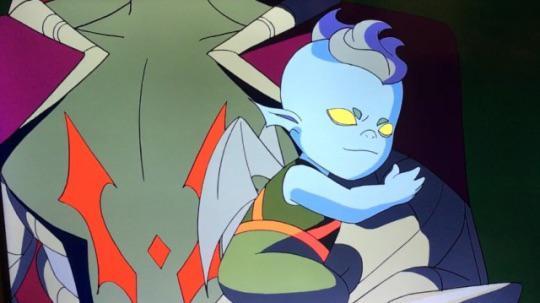
Very cool, ND.
There's more, though. Hordak's red and black color scheme? His dark eye makeup and lipstick? Very Evil Overlord chic. But nope! Actually these are actually expressions of individuality on a level that Hordak knows would be abhorrent to Prime!
Reading between the lines, I see this as Hordak desperately trying to reconcile two diametrically opposed beliefs in his head: (1) devotion to Prime, whose approval he desperately craves, and (2) maintaining some degree of unique personhood, of Hordak, from which to draw strength. Because a failed, defective clone cannot survive on a hostile world, cut off from the hivemind and from Prime's light. A failed clone cannot create an empire to offer Prime as tribute, nor build a spacetime portal from scraps and memory to call Prime back. A failed clone cannot create cybernetic armor to keep his hurting, weakened body alive; to force himself to keep going no matter what, to fight through the pain and the doubt by sheer force of will.
But maybe Hordak can.
And so there it is. Hordak had plenty of time to gain and explore his individuality while separated from Prime, but I think the reason he did it so effectively (while still deluding himself that Prime would forgive him for these little sins, if only Hordak could prove his value) is because he had to.
Wrong Hordak gained his individuality surrounded by kind, quirky people who took care of him; Hordak was ripped from the hivemind by Prime himself and had to fight for his survival against all odds. And that produced a dangerous and damaging foe for Etheria. But it also produced the one clone with the strength of will to defy Prime himself.

This is long and rambling, but ultimately my point is that 1) I love Hordak, and 2) I love love love love that the show was so clever about his characterization. We learn so much about him and how much progress he's already made in breaking from his psycho abusive cult upbringing, and we don't even recognize it until the show wants us to. Hordak had come so far, all on his own, before he met Entrapta. She just helped push him over the edge and finally realize (at least consciously) that Prime's worldview might not be the correct one.
Idk, I just don't know if I've ever seen all the trappings of Basic 80's Villain(TM) so successfully subverted, where looking back 4 seasons later is actually a smack in the face with the "effective character building" stick. Amazing.
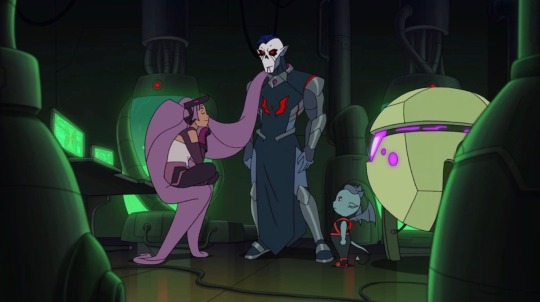
#spop#she ra#she ra and the princesses of power#hordak#entrapdak#entrapta#horde prime#Spacebat#Deep character analysis#Gotta love clever writing#Seriously I could go on about this show for ages#I just love the characterization for everyone but especially Hordak#Best spacebat#I mean I love Wrong Hordak too but you know
2K notes
·
View notes
Text
Both Catra and Adora defying death at the height of their character journeys in such a powerful and subversive way. Whenever I think about it deeper, both deaths were very traditional and demeaning ’feminine’ deaths. Catra had a man literally controlling her body and mouth to fight against her friend (and lover) for seemingly his own amusement, and when she resisted, he disposed of her by throwing her off a cliff (the gwen stacy method), she was barely present in the entirety of the episode, her agency stripped (not for the first time), the emotional stakes were felt, but by Adora not catra and how bad she felt to see catra this hurt, even though catra was the one in pain, we don’t focus on catra’s perspective at all during it, so if she did die at the end of it, she would have just been another name to add to the list of female love interest violated and killed by the hand of men for the development of the main character’s story. Except she didn’t die! that wasn’t her end, but her beginning, that part was just a step on the rest of her life that she grew and recovered enough to have power to control. To change.
As for Adora, there’s no shortage of self sacrificial women and female martyrs both in history or fiction, it’s been romanticised and encouraged since the dawn of the patriarchy for girls to grew up being conditioned into giving up their own needs, desires and even lives and health for the convenience and goals of others, and when they obey that to the extreme (like with the failsafe) they’re celebrated as the ultimate heroes. The perfect women are dead women after all. but instead Adora doesn’t die not just because of her power or sense of duty but because she learns to be selfish and choose something for herself for once and that’s what ultimately saves her. She rejects her conditioning and the message of what a hero must be and choose to live for her own self. Self love is radical.
#Especially for women#so it’s basically women in refrigerators vs female sacrifice#catradora through feminist lens#Adora#Catra#catradora#spop#she-ra#she ra and the princesses of power#analysis#Mine
258 notes
·
View notes
Text
Failsafe puts on stilettos and does a tap dance on my heart for a lotta reasons, but these are the ones i feel like ranting on today~
i can’t get enough of this moment. when adora finally sees it and takes the first opportunity she gets to say it right to this bitch’s face--
it seems like the whole episode are these shared, full-realizations of the other’s trauma and that, while their experience of it differs and so it produced distinct effects for each of them, it’s still very real and has taken its toll on them both--

and is still taking its toll.
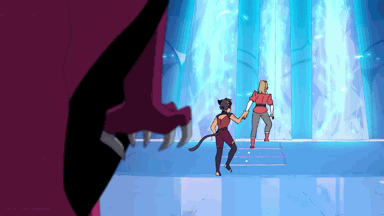
and it’s a savage slaughter on my emotions when catra calls out sw ^^ for her typical tricky bull shit and she audibly says “why are you surprised by this?!” & immediately her voice gets lost in the others' and their indignant words in defense of adora, but catra goes on to say something like:
“she doesn’t care about adora! adora can’t even care about herself!”
and that’s it. the moment you know: catra’s gotten to the bottom of it. she’s figured it out and she's prob so angry at herself for (due in part to her own trauma tho) not seeing it sooner.

all those times she said adora just needed to be the hero, it was quite literal in a way far more unhealthy than catra had ever realized. any problem that arose; if there were lives on the line; adora needed to fix it, no matter the cost. if it had to be someone, it needed to be her. a necessity of which praise was a small perk but for which glory was never the goal. on the contrary, it was even more devastatingly toxic for adora than that.
want is not a sin. there are many clarifications i could make to that, but if you're a decent human being, i shouldn't need to.
and yeah, they both fall prey to the trauma of their careful grooming one more time.

but ultimately, they both embrace love in order to overcome it.
catra decides that if adora can’t let up and simply has to do this, she’s going to do it with her. disregarding the insecurity that adora doesn’t need her, so she’s just following her around; instead, catra stands beside adora with the conviction that she’s there because that’s where she wants to be.
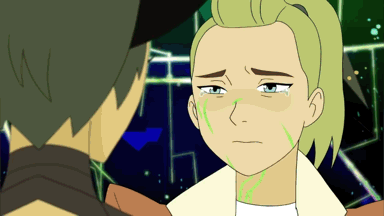
and adora finally allows herself to want love. as adora. just adora.


not only acknowledging that she deserves it,
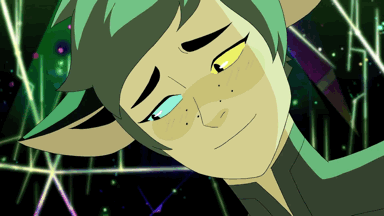
but even letting herself accept it.

<3
#spop#she ra#catradora#spop failsafe#spop heart part 2#adora#catra#spop rant#spop analysis#she ra meta#fck off shadow weaver!#spop gifs#love >
125 notes
·
View notes
Text
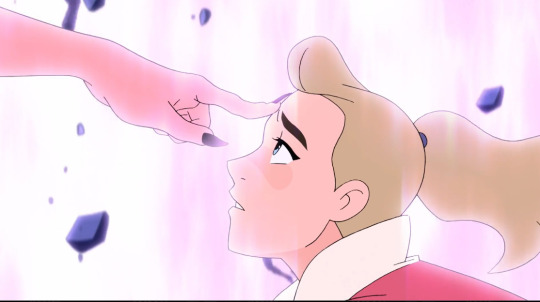
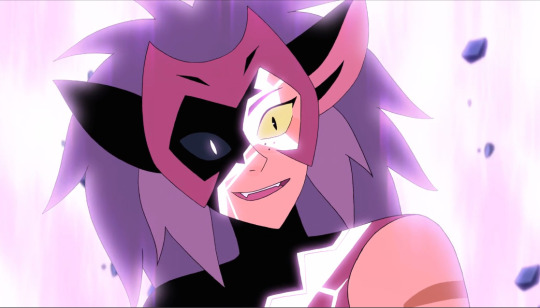
this was so fucking peak…like okay doomed romance
#catradora#catra#adora#she ra#spop#i��ll write coherent analysis later this is one of my fave scenes despite s3 them being at their worst to one another
237 notes
·
View notes
Text
I think the s5 finale of she Ra is really the first time we see Adora really relax. Of her own violation. And honestly when she does at the end, it makes me wanna tear up.
Like you see her body physically melt. Her expression relaxes. She’s done. She’s free. She can just be Adora.
119 notes
·
View notes
Text
something that i've always found really funny is catra's s5 plot armor, or rather, design armor i suppose.

to start with, adora (and bow and entrapta) had no idea catra was with glimmer on the velvet glove.
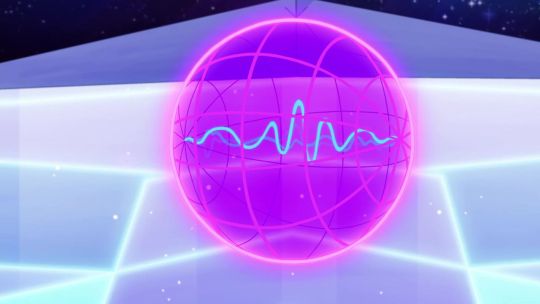
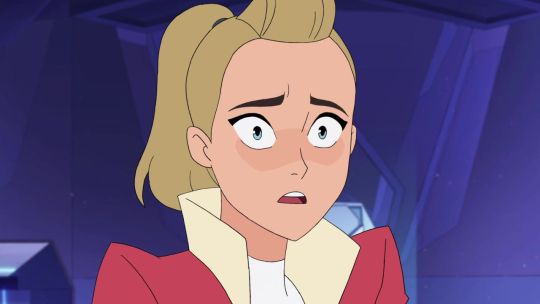
so they rescue her, and surely her chipped outfit, which she's wearing, is the only one she has after prime discarded her former horde uniform.
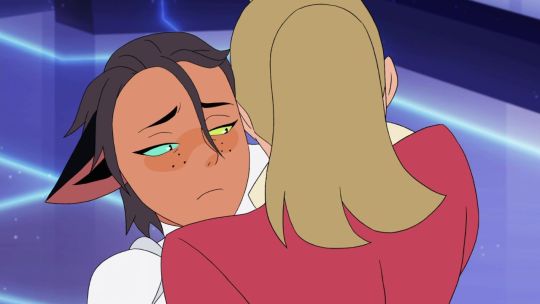
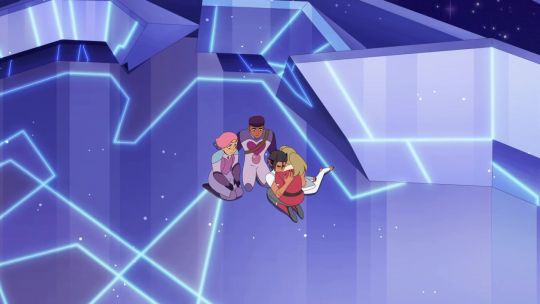
but then we see her in the same pajamas that she wore in the fright zone, just without the horde symbol, and remember that adora's looks different.
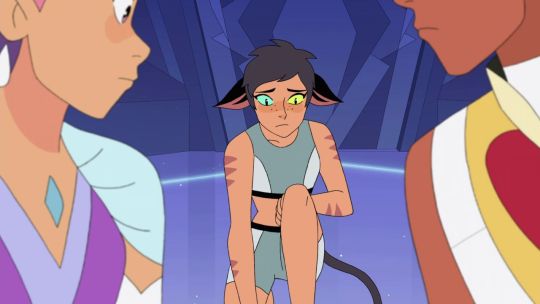
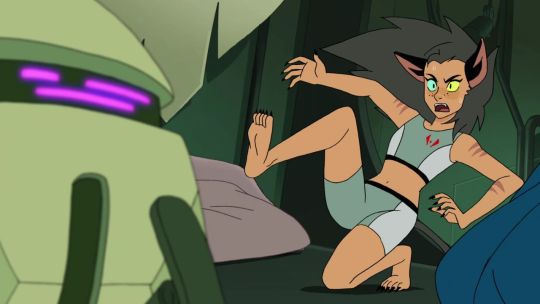
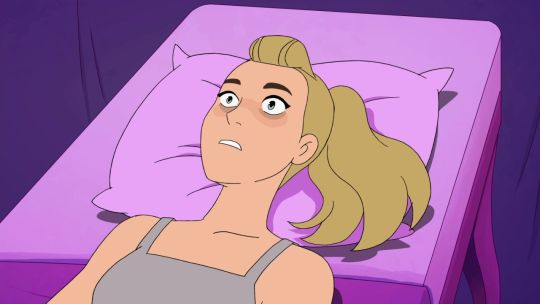
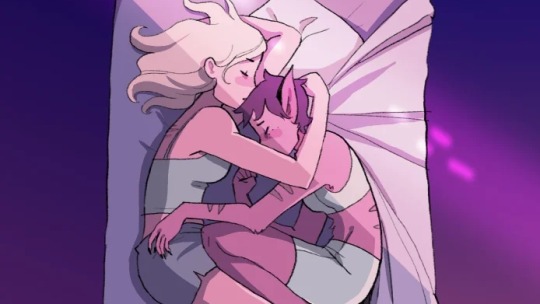
in the next episode, she's wearing an alternate version of her previous red & black uniform, which there's no way could been packed on the journey to save only glimmer, and they wouldn't have cared about leaving replaceable clothing behind on the ship.


also another thing i want to point out is that the back of the torso is mostly removed, likely by catra's claws due to the fact it had the horde symbol on it and she was now part of the rebellion. but i'm not counting this part since it makes sense.
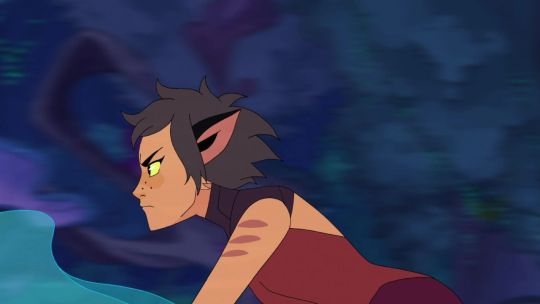
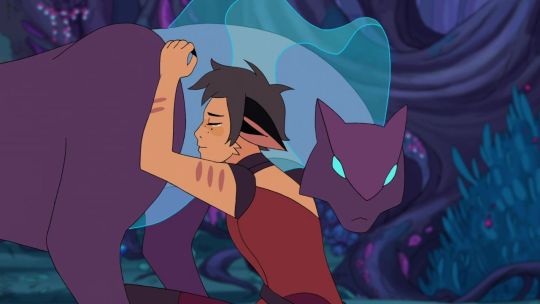


anyway, she gets a whole space suit made for her by entrapta, who, again, wasn't aware catra wasn't on etheria anymore, let alone would want to leave prime.
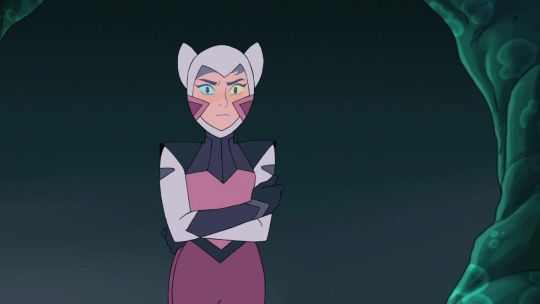

and here's a bonus just because i can't tell: was this cloak made with a place for her cat ears to fit into, or is she just poking through the original fabric?
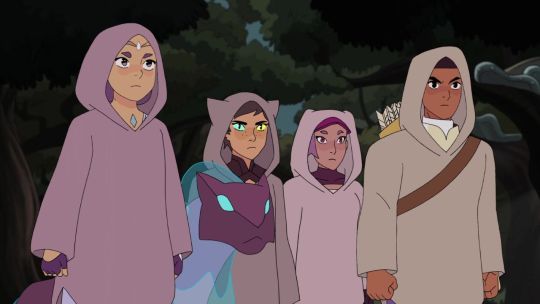
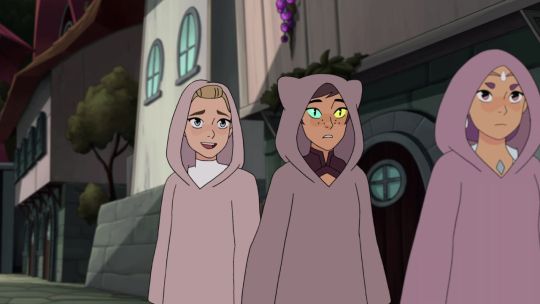
overall, this isn't a plot hole and i don't actually care about these inconsistencies since it's not a serious issue, if one at all. but this has always been something i wanted to share with the fandom since i love details!
#spop#she-ra#she ra#she ra and the princesses of power#s5#season 5#season five#catra#catradora#spop analysis#she-ra analysis
134 notes
·
View notes
Text
catradora and the perfect victim complex
(i literally fucking think about this all the time so this just gonna be a rant lol)
i really, truly think that people in general don’t put the effort into understanding characters who are imperfect victims. for them, it destroys the appeal of victimhood. victimhood (especially when the victims in question are girls, women, femme presenting people, etc.) needs to be beautiful and tragic. think characters like ophelia, snow white, odette, juliet, the lisbon sisters. otherwise, their victimhood is no longer attractive.
catra is an imperfect victim. shadow weaver’s abuse did not make her soft, weak, timid, or fragile. it made her bitter, angry, and resentful.
i once saw a catra anti saying some bullshit about how they might’ve liked catra more if the writers had spent more screen time showing shadow weaver abusing her, specifically her when she was a kid.
this person wanted to see catra’s pain as beautiful. they wanted to see her ONLY as a child to be pitied, the little kid who cowered in fear instead of fighting back, and not have to acknowledge catra’s more complicated character traits.
i also think this is why these same people often talk like they love adora, like “adora deserves better than catra” and all that shit. adora (to them) is easier to see as a perfect victim. shadow weaver’s abuse made her obedient and self-sacrificing. it made her put others before herself, even to the point of fucking death. adora is selfless and brave. she’s so determined to be a perfect hero, to protect people, to care for people, to love people. these traits are easier to romanticize. it makes her seem beautiful.
if you ask me, this is a really fucked up way of viewing adora. i don’t love adora bc she’s a “perfect victim”, i love adora bc she, like catra, is also flawed. adora’s determination to be perfect leads her to abandoning catra. her inability to empathize with catra leads her to behaving the way she did in taking control. adora isn’t fucking perfect.
(for context i do also think that catra was in the wrong in that episode too, but i feel like we don’t talk enough about how badly adora was handling the situation. like seriously girl catra is here basically telling her “i don’t trust you bc i don’t believe that you could ever love me bc i’m inherently fucked up and unlovable” and adora’s immediate reaction is to blow up at her. it makes sense given what adora has just done for her, but it’s another example of adora being incapable of empathizing with catra. also calling her a stubborn brat? yeah uh that wasn’t funny adora, especially not with the ways that shadow weaver talked about catra.)
but i love that adora is flawed, and i love that catra is flawed. they’re not archetypes. no real person experiences abuse like they did and comes out perfect. catra’s intense fear of abandonment and resentment issues are a very fucking real response to the way she was traumatized. regardless of how ugly it is.
at the end of the day, i think that people can’t wrap their brains around this concept and refuse to empathize with imperfect victims bc they don’t want to admit that they, too, are imperfect victims. the perfect victim isn’t real. it’s a fucking myth.
in real life, people are messy and complicated, like catra and adora. it’s why i love them :)
ugh i could literally go on about this FOREVER i swear.
#catradora#spop#she-ra#catra#adora#catradora brainrot#analysis#perfect victims#she ra and the princesses of power#the nuance in this show is so so fucking good#i love these girls so much#they are everything to me
118 notes
·
View notes
Text
ngl I cannot bring myself to agree with the "Catra's redemption was rushed" crowd, whether they like the show overall or not. Perhaps I have a different view of redemption than most. To me, a redemption arc begins when a character experiences guilt and remorse for their actions, which Catra expresses in early season 4 when she has a nightmare about how she threw Entrapta under the bus and activated the portal. Catra's nightmare shows her images of Entrapta and Adora questioning her, placing the onus for her actions on her: "What did you do to me?" "Why did you do it?"



Derailing: Why did she do it? Not because Adora made her. Catra can't use that excuse anymore. "Why did you do it?" Adora also asked Catra this as a child (s5ep3 Corridors) after she hit Lonnie. Back then, it was because Catra was terrified of losing Adora's friendship and thereby being "discarded" by Shadow Weaver. She was scared for her life. But now? Catra didn't activate the portal for safety; she did it to win. She did it to prove to the world she could be victorious, to Shadow Weaver, Hordak, Adora, to everyone who refused to believe in her. Yet after pulling that lever, Catra's true desires were revealed; she wanted to be relatively safe, surrounded by friends, allowed to love Adora, and recognized for her worth. She didn't need to dominate. When that false reality shattered, Catra's hope was shattered with it. She fell back on her sense of injustice, reduced to her own agony, inflicting it upon the world and herself. After the portal, Catra had to face that her goal of ascending through the Horde was hollow.
One could even argue Catra feels regret at the end of season 3 with this look she gives Adora of "ohhh I fucked up, I fucked up big time." Catra looks sickened, with herself and with how Adora now sees her.



From this point in the story, it was blatant to me that Catra was headed for redemption. Catra clearly knows that she went too far and may have completely burned every bridge and ruined all hope of redemption. But she can't yet confront that her ambitions will not fulfill her. So, she doubles down. In classic sunk-cost fallacy fashion, Catra seemingly strengthens her allegiance to the Horde, taking control and commanding operations. Despite herself, Catra's guilt creeps up on her, not only through the nightmare but also in her approach to Adora. Unlike in s1-3, throughout season 4 Catra avoids Adora almost entirely, only engaging from afar. Catra evades confronting the amount of pain she's caused Adora, the seemingly irreparable chasm she's clawed between them, focusing solely on strengthening the Horde. She still cares, but denies herself that regular interaction.
This suppression poisons Catra's fragile friendship with Scorpia as well. Catra continually lashes out at Scorpia, projecting her own insecurities and frustrations onto her. Her behavior pushes Scorpia away and causes her to leave the Horde, to leave Catra. This is the first time someone left because of her. It almost feels like self-sabotage, Catra pushing Scorpia more and more, becoming crueler, creating reason for her to defect. Catra doesn't feel worthy of Scorpia's friendship, of anyone's. And so Scorpia's kindness enrages her, reminds her of how far she's fallen, and how much lower she will go. Catra also lashes out at her former comrades, Lonnie, Rogelio, and Kyle, further isolating herself from anyone who cares about her, pinning her entire existence on proving herself through Horde victory. She failed in the friendship department; the Horde is all she has left.



But Catra can't fool herself forever, and she certainly couldn't fool Double Trouble. After defeating Hordak, who does Catra have left to prove herself to? Horde Prime? Herself? Neither of those people care. For the first time, Catra is completely alone, and Double Trouble doesn't let Catra hide from how she got there. They read Catra to filth, summarizing what I wrote above: Catra pushed all her friends away in pursuit of a villainous role she didn't desire; her heart laid elsewhere. Now both goals are in ruins. Depleted, with nothing left to prove, Catra asks Glimmer to kill her. Catra's guilt permeated season 4, seeping into all her relationships and degrading her mental state. But guilt is meaningless without action. Which brings us to season 5.

I got soooo off track, so I'll try to wrap it up. So yes, Catra's redemption arc started in s3/4 when she first felt remorse for her actions - not in season 5. Even then, her change took time to develop. Initially, Catra still tried to align herself with Prime, but convinced him to spare Glimmer, indicating her shifting allegiance. The girls begin to empathize with each other and Catra sees how much Glimmer cares for Adora and the life Adora has built for herself. Fully expecting to die, Catra chooses to throw away the small amount of favor she earned with Prime and save Glimmer, therefore protecting Adora. Catra apologizes to Adora for everything. Her body is stolen from her and she dies as a consequence of her actions. She's revived and chooses to join the Rebellion. She slips up but genuinely tries to make amends, not for her own conscience but because it's right. She wants to do better. She accepts ire from the Princesses without retaliation. She defends Adora from Shadow Weaver. She gives Adora the strength to choose to live and allow herself to desire, and together they save the world.


This redemption is not immediate. It was given time, the foundation established across seasons. Catra does not have a sudden change of heart. It builds gradually, even within the final season. Nothing about Catra's arc was rushed and nothing about it was easy. Each day, she fought the harmful instincts cemented in her from years of abuse to become a better person, experiencing realistic regression and growth. Catra was tormented by others and herself for her entire life and all it did was make her worse. She deserves a soft universe, the new world she and Adora created together
#cl thoughts#lowk may need to make a short version#a lot of the detail is unnecessary but I wanted to write about it. so#disclaimer: a) haven't watched spop in a few yrs so I may have details wrong b) people are allowed their own conceptions of redemption#...yeah I added an AURORA reference at the end#catra analysis#catra meta#spop analysis#spop meta#redemption arc#catra#spop#she ra and the princesses of power#not sure how I feel about the world choice of “deserves” because what does that even mean? but I can't think of a better fit#catra defense#shera#she ra#she-ra#catradora#my sentence structure in this one is killing me I keep doing the same thing over and over :') I need an editor#this was supposed to be short rip
152 notes
·
View notes
Text
Let's talk about Catra and Hordak
Since this is where most of the drama comes from
It's no secret that Entrapdak shippers are anti-catradora and vice versa. Why? Mainly, the issues people have within these ships are not the ships themselves, but the characters within them; mainly Catra and Hordak. Entrapdak shippers hate Catra because of the toxic relationship she had with Entrapta and other characters. Because of what she did to Entrapta, tasing her and sending her to beast island, and how she just got worse and worse in season 4.
The same could be said about Hordak, regarding the Catradora shippers who despise Hordak for most of what he's done. It's no secret he took over the scorpion kingdom, created the Fright Zone, and brainwashed and conditioned a lot of Etherians into believing the cause, just as Horde Prime did to him. And a lot of that was the cause of a lot of Adora and Catra's issues.
Here's the thing though
I really think Hordak and Catra are similar in a lot of ways. Both grew up in a abusive environment forced to portray themselves as perfect in order to no longer face any abuse from their respective "mentors".
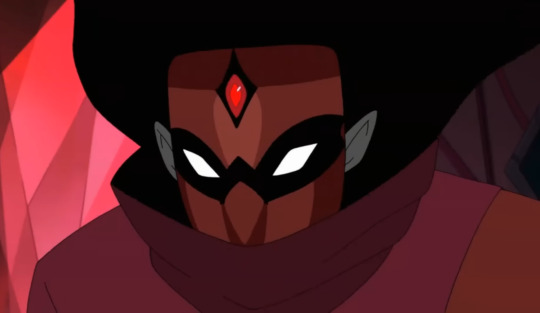


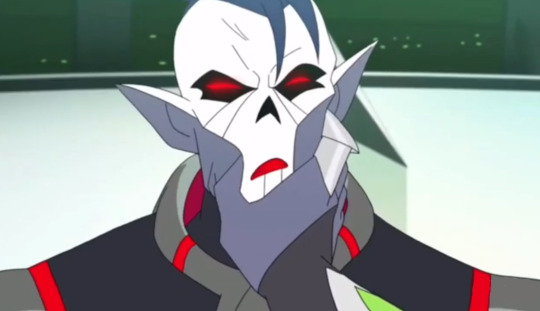
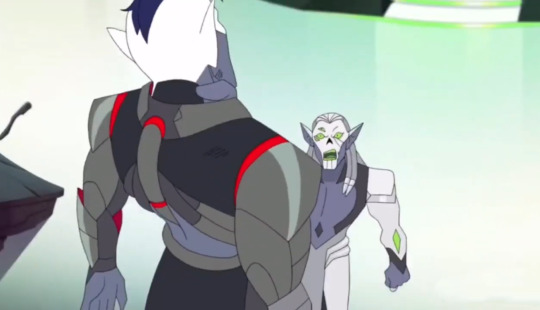
But both Shadow Weaver and Horde Prime would never see either of them as nothing but inferior.
They both suffered years of abuse, Hordak perhaps even longer. And yes, the actions of Hordak had contributed to Catra's abuse as well, but it is a cycle. A cycle they both decided to break.

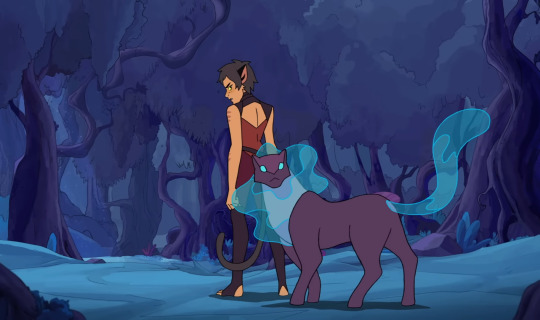

Catra overheard Shadow Weaver telling Adora that she was a distraction to her, then leaving. Leaving, because she wasn't going to be a part of Shadow Weaver's manipulation any longer. And yes, she may have left due to that very manipulation, but eventually she stays, at the very end, together with Adora.
Then there's Hordak
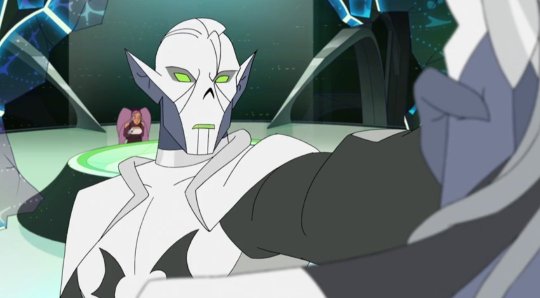
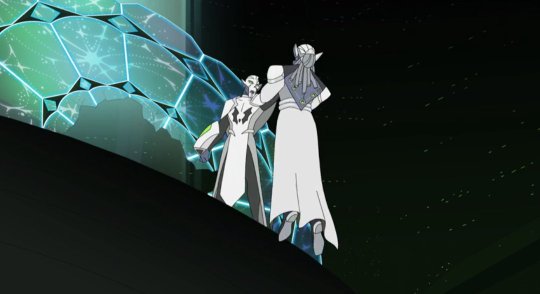
Ever since meeting Entrapta again, he chooses to hide his returned memories this time and at the end, when Entrapta is being held in front of him and prime, finally he sees the error of his ways, breaking the cycle quite literally. By throwing prime off the ledge.
He does this great speech about giving himself a name, a life, making a friend. He defies Horde Prime's will and finally, FINALLY breaks the cycle and gains control of his independence. And yes, there's that whole thing that happened after, but that was Prime, not him.
My point is, we should stop hating on each other and the characters because people, it's just a show, these are fictional characters with flaws that any person in real life would go through. Not to mention, again, how similar Catra and Hordak are.
If we hate on Catra for the things she did, we have to hate on Hordak for the things he did too. And vice versa. They both had terrible pasts, a long list of crimes, but they're making up for it in their own ways. Redemption is a long road, but it's a good one.
Anyway, this is just my opinion and analysis on the whole thing, you don't have to agree, but let's try to get along alright? Fandom fights and shipping wars are never fun and I really think you guys take defending and attacking a fictional character from a fictional show way too seriously.
I still love Entrapdak so much but I'm not gonna attack Catradora or Catra Enjoyers over it. And if they say something about Hordak or Entrapdak I don't like? The block buttons right there. There's really no need for so much drama guys.
Thanks for listening 🙏🙏🙏
#entrapta#spop#hordak#entrapdak#she ra#shera#she ra and the princesses of power#catradora#discussion#analysis
99 notes
·
View notes
Text

For me, Catra is an incredibly relatable character. I see so much of my teen self in her. And I can't help but feel sorry for her.
Every time he reaches for acceptance from terrible parental figures or pushes away those trying to be her friend, my heart aches.
It reminds me of every terrible decision I made as a teen. And just like me, she's unable to listen to good advice. We both had to learn the hard way how to get beyond our trauma.
And that involved us hitting rock bottom. Fighting to claw our way to a healthy mindset and open ourselves up to others.
Seeing her heal and be vulnerable with others makes me cry with joy. I am so happy for her.
And I am happy for myself.
58 notes
·
View notes
Text
Catra Rant! >w<
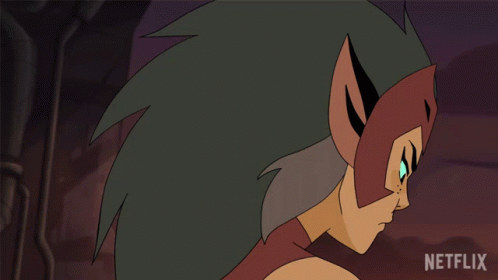
Everything has a cause and effect. If you don’t water a flower it will die. If you tell a child their worth and literal life is based on and how much another person loves them, they will believe you. That child will learn to do anything for that person’s affection, as she was told she would be literally killed if that person didn’t like her anymore.
What she-ra does amazing at showing is how someone can do bad things, but that doesn’t make them a bad person. Catra obviously throughout the show makes many bad choices and hurts many people but that is because she was desperately fighting to make herself a title and give herself worth when Adora left.
A lot of anti-catra’s make the argument that Catra had the opportunity to leave with Adora, but let me count the times and reasons she (and you) wouldn’t want to go with her, keeping in mind how her worth was defined by her relationship with Adora her whole life:
When Adora initially left she told Catra to stay behind so she could sneak out and then from Catra’s perspective ran away with two strangers who where now her best friends (replaced Catra) and the only reason she asked her to come along was because she was there in the moment. Adora never tried to go back for her.
She went out of her way to save glimmer and bow after princess prom, but Catra damn well knew Adora never came back for her. And yet Catra still saved her from the horde and gave her back her sword. Does Adora understand why? No, does Catra even know why? Probably not consciously, but subconsciously it’s because she cares so deeply about Adora, she just won’t admit it to herself because the ways she was betrayed by Adora.
And THEN Adora (accidentally) tells Catra that Shadow Weaver abandoned and used Catra to get to Adora which sends her in a complete mental spiral and she ends up setting off the portal in a manic episode.
in the portal, Adora forcibly Tazed and kidnapped Catra to bring her to the sword with her, where her intention was good but also Tazing someone you love to force them to come with you? Not very smart, I’d be pretty pissed too.
At that point Catra was so caught up in being her own person, even if that meant being the bad guy, just to separate herself from someone who hurt her so badly. It makes sense that it took her loosing Hordak’s trust, Scorpia’s relationship, DT’s relationship, her title, EVERYTHING for her to fully understand that “oh shit I need to move past what Adora did to me and fix what greater good I can while I’m still alive”
Everything that happened to Catra was the cause for her actions. Cause and Effect. Does that make it okay? No. Does it make her a bad person? Also no.
You while reading allat:
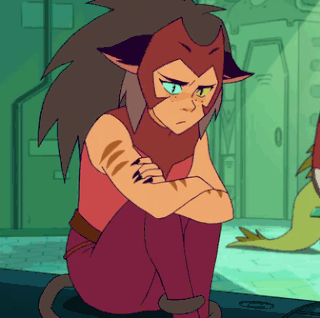
I’m sorry <3
#analysis#she ra#she ra princess of power#spop#catra x adora#gay#catra#media analysis#theory#adora x catra#adora#she ra adora#adora and catra#spop adora#melog#shadow weaver#glimbow
90 notes
·
View notes